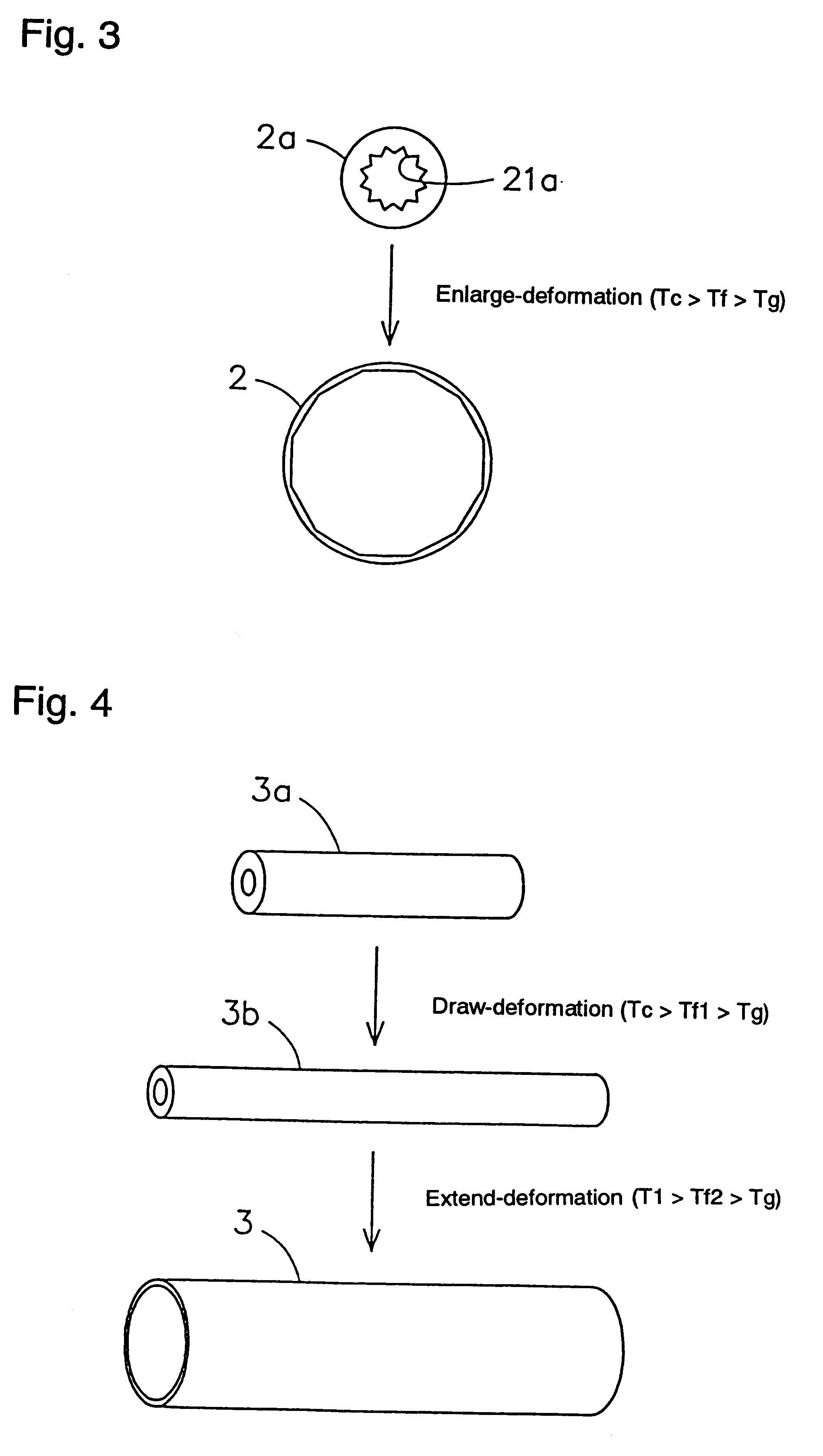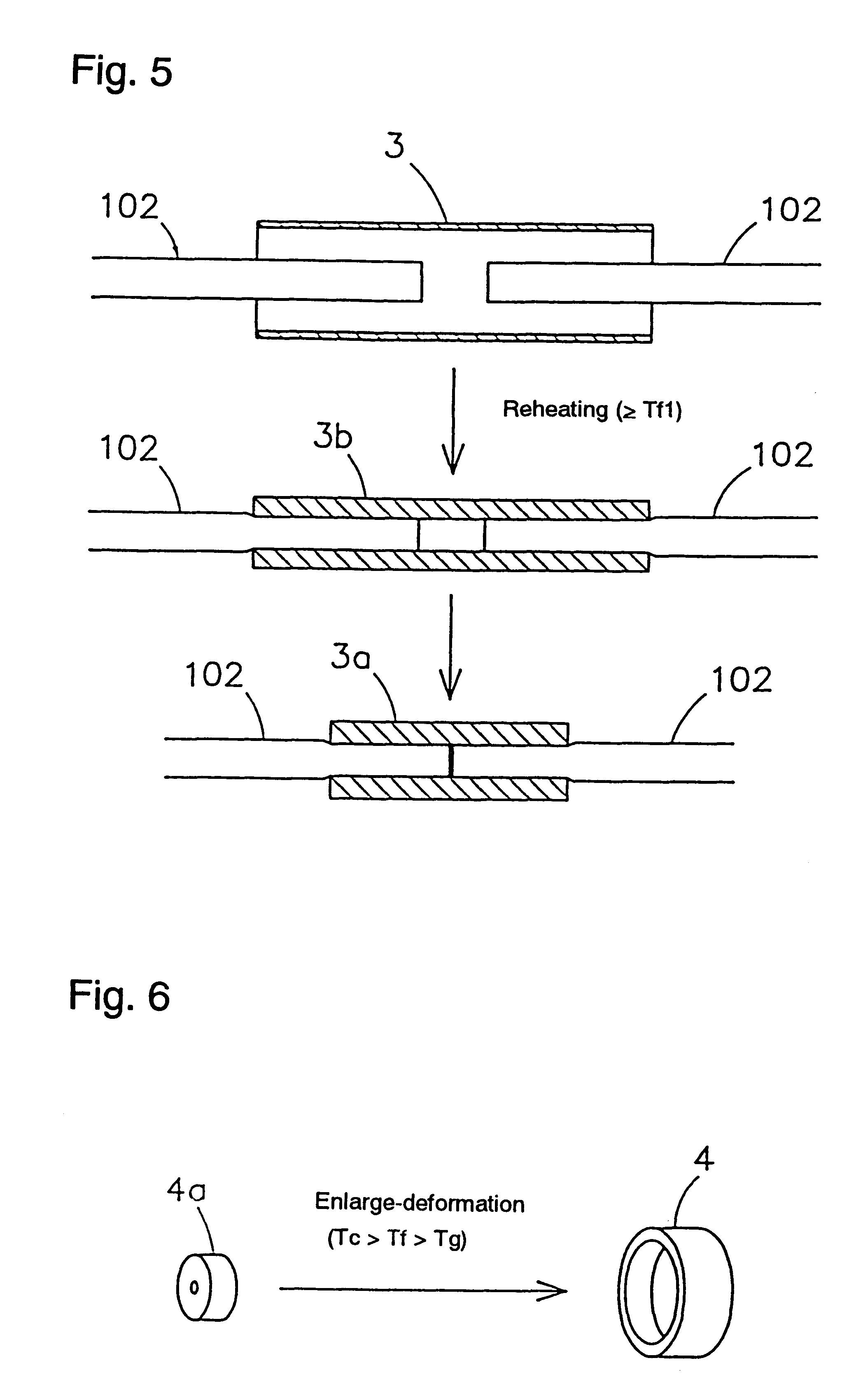Shape-memory, biodegradable and absorbable material
a biodegradable and absorbable material technology, applied in the field of shape memory, can solve the problems of inability to biodegrade and absorb in vivo, and achieve the effect of facilitating and surely performing anastomosis
- Summary
- Abstract
- Description
- Claims
- Application Information
AI Technical Summary
Benefits of technology
Problems solved by technology
Method used
Image
Examples
example 1
DL-Lactide was subjected to ring-opening polymerization to give poly-D,L-lactic acids (PDLLA) having viscosity-average molecular weights of 400,000, 250,000, 150,000, 100,000 and 70,000. These PDLLA were press-molded at 160.degree. C. and 100 kg / cm.sup.2 and thus 5 molded PDLLA articles in the shape of round bars (diameter=10.0 mm, length 20 mm) were obtained. The glass transition temperatures of these molded articles all fell within the range of from 50 to 56.degree. C.
Next, these molded articles were each heated to 60.degree. C. and deformed into molded articles in the shape of thin and round bars (diameter=5.8 mm, length=60 mm) by compression molding. Then the resultant molded articles were fixed to the shape by cooling as such at ordinary temperature to give 5 shape-memory biodegradable and absorbable materials with the memory of the original shape of the round bars. The sectional area and length of a shape-memory material were referred respectively to S.sub.1 and L.sub.1 while ...
example 2
D-Lactide and L-lactide were polymerized at a weight ratio of 25:75, 40:60 and 50:50 to give 3 PDLLA having a viscosity-average molecular weight of 150,000. These PDLLA were press-molded at 160.degree. C. and 100 kg / cm.sup.2 and thus 3 molded PDLLA articles in the shape of round bars (diameter=10.0 mm, length=10 mm) were obtained. The glass transition temperatures of these molded articles all fell within the range of from 50 to 60.degree. C.
Next, these molded articles were each heated to 65.degree. C. and deformed into molded articles in the shape of thin and round bars (diameter=5 mm, length=40 mm) by plastic compression. Then the resultant molded articles were fixed to the shape by cooling as such at ordinary temperature to give 3 shape-memory materials (deformation ratio: R.sub.S =R.sub.L =4.0) with the memory of the original shape of the round bars.
Subsequently, these shape-memory materials were each immersed in physiological saline at 70.degree. C., i.e., higher than the one em...
example 3
D,L-lactic acid / glycolic acid copolymer (D,L-lactic acid glycolic acid=97.5:2.5) having a viscosity-average molecular weight of 200,000 was press-molded at 180.degree. C. and 100 kg / cm.sup.2 to give a molded article in the shape of a round bar (diameter=13.0 mm, length=30 mm). The glass transition temperature of this molded article was 51.degree. C.
Next, this molded article was heated to 65.degree. C. and deformed into another molded article in the shape of a thin and round bar (diameter=7.5 mm, length=90 mm) by plastic compression. Then the resultant molded article was fixed to the shape by cooling as such to give a shape-memory material (deformation ratio: R.sub.S =R.sub.L =3.0) with the memory of the original shape of the round bar.
Subsequently, this shape-memory material was immersed in physiological saline at 67.degree. C. After the shape-recovery, the recovery ratios (sectional area and length) were determined. Table 3 shows the results.
TABLE 3 Degree of Sectional area Length ...
PUM
| Property | Measurement | Unit |
|---|---|---|
| crystallization temperature | aaaaa | aaaaa |
| Tc | aaaaa | aaaaa |
| melting temperature | aaaaa | aaaaa |
Abstract
Description
Claims
Application Information
 Login to View More
Login to View More - R&D
- Intellectual Property
- Life Sciences
- Materials
- Tech Scout
- Unparalleled Data Quality
- Higher Quality Content
- 60% Fewer Hallucinations
Browse by: Latest US Patents, China's latest patents, Technical Efficacy Thesaurus, Application Domain, Technology Topic, Popular Technical Reports.
© 2025 PatSnap. All rights reserved.Legal|Privacy policy|Modern Slavery Act Transparency Statement|Sitemap|About US| Contact US: help@patsnap.com



